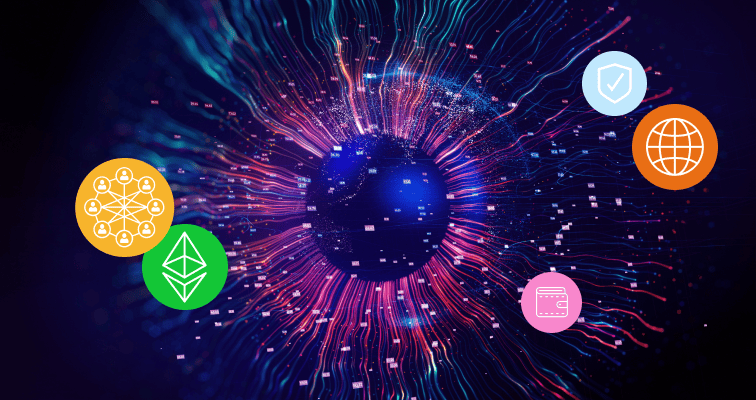Looking to learn what Decentralized Finance (DeFi) is, how it works and how it is used? Our guide introduces the technology and its common applications.
One of the main attractions of crypto is its ability to make payments universally accessible to anyone, no matter where they are in the world, without being beholden to the centralized gatekeepers we know as banks. Therefore, it is not surprising that the Decentralized Finance (DeFi) or Open Finance movement has begun to gain popularity and support.
But what is DeFi? Imagine having a global, open alternative to every financial service you use today, such as saving accounts, loans, trading and insurance, that are accessible to you anywhere in the world — as long as you have a smartphone and an Internet connection.

What exactly is DeFi?
DeFi is directly connected to financial smart contracts, decentralized applications (DApps), and protocols that are unique to Ethereum, the second-highest market cap cryptoasset after Bitcoin.
Some of the better-known DeFi platforms include decentralized exchanges, lending and borrowing markets and tokenized physical assets such as gold. It has even expanded to include other financial services such as derivatives, payment networks and insurance.
If you are a newcomer to the world of crypto, this is probably like reading an alien language. So let’s break down the key elements that power DeFi:
Smart contracts
These are at the core of what makes Ethereum unique. They allow applications or scripts running on its network to create digital assets. This enables complex irreversible agreements, such as payments or transfers, to be authorized with no need for a “middle man”, which would traditionally be a bank or some other established financial institution.
Decentralized Applications (DApps)
A DApp is a software application that runs on a distributed peer-to-peer network rather than being hosted on a centralized server. They can be like any app that you access using a web browser or your smartphone, except that it runs on a decentralized network such as Ethereum.
Decentralized Exchange (DEX)
A decentralized exchange is similar to an online trading platform like eToro, except that it is run by smart contracts using the Ethereum blockchain. Instead of traditional assets, it allows you to trade crypto coins and tokens.
The main benefit of a DEX is that due to it being decentralized, the risk of losing your assets to external hacks or internal fraud is greatly reduced.
Learn more about DeFi, what it can do and what makes it special with this informative video:
How is DeFi different from traditional finance?
So why would you ever consider using DeFi instead of traditional banks & trading platforms? Some of the key advantages this new form of finance offers are outlined below.
Less room for human error
Instead of relying on humans to manage operations, DeFi relies instead on rules written in code (smart contracts). Once your smart contract has been deployed onto the network, the DApp can run itself with minimum human interaction.
Full transparency
Due to the decentralized nature of blockchain, the smart contracts are essentially open source and can be audited by anyone. This results in a high level of user trust, since everyone has the opportunity to learn the contract’s code or find bugs. All transaction activity is also public for anyone to view.
Tip: Privacy is retained using DeFi since every transaction is not tied directly to your real-life identity.
Access anytime, anywhere
DeFi and the DApps that power it are designed to be accessed globally, free from the constraints of international borders. Whether you are in Sydney or San Salvador, you can access your DeFi services with just an Internet connection, although it is important to remember that local regulations regarding digital currencies may still apply.
No red tape
DeFi is ‘permissionless’, which means there are no middlemen to deal with or lengthy forms to fill out. You can interact directly with the smart contracts from your crypto wallet.
Flexible user experience
Since DeFi is ‘permissionless,’ anyone has the ability to build or modify them. Think of smart contracts like an open-source API: if you do not like the interface of one of your DApps, you can simply use a third-party one or even build your own.
Modular
New DApps can be freely created or customized by seamlessly combining other DeFi products like digital Lego pieces. Size is no issue, with large and complex DeFi platforms such as decentralized exchanges or prediction markets having the ability to form entirely new products.

Are there any drawbacks to using DeFi?
Despite its benefits, there are still a number of drawbacks and challenges that come with using DeFi and DApps that you should be aware of.
Slower transaction speeds
Decentralized blockchains are currently slower than their centralized counterparts, and this impacts the DApps that are built on top of them. Despite this, many developers are optimizing their DApps to negate this shortcoming, and the technology itself is improving constantly.
No safety nets
Seen by some as a core tenet of crypto and by others as one of its biggest hurdles for mass adoption, DeFi transfers all of the responsibility from the intermediaries to the user. If you accidentally transfer funds to the wrong address or forget the passphrases to your wallet, then your money is gone.
There is no bank customer support line you can call to undo a transaction or regain access to your account.
Steep learning curve
Blockchain technology is inherently complex, and the additional steps required to use DeFi services can be quite daunting to newcomers, which is compounded by the risk of one mistake resulting in losing your funds forever. Many believe (with good reason) that creating a more user-friendly experience is key to crypto achieving mainstream adoption.
Tip: Visit the eToro Academy to learn more about crypto, including blockchain technology, the Bitcoin Lightning Network, and more.
What is DeFi currently being used for?
While the potential use cases for DeFi are enormous, it is an emerging technology that is still in its infancy.
Outside of DEX’s, the main DeFi financial service being offered is decentralized borrowing and lending. This allows users to either invest digital assets to earn interest or stake them to borrow stablecoins that have value pegged to the US dollar.
In a way, it is like the blockchain version of fintech peer-to-peer lenders. Now, let’s break down the two smart contracts that facilitate this service.
MakerDAO and DAI
MakerDAO is a smart contract that fulfills the borrowing function. It works by opening a collateralized debt position (CDP) staked using the Ethereum crypto. The Ethereum then acts as collateral, and you can borrow funds in the form of a token called DAI, which is a stablecoin with a value equal to USD.
An annual interest rate is paid on the ‘loan,’ called a stability fee, which acts as a safeguard against overinflation of the total supply of DAI.
In a sense, MakerDAO acts in a similar way to a central bank by issuing DAI and also ensuring that its value remains stable. For example, if the supply of DAI increases too much and causes its value to fall below $1, MakerDAO will raise the stability fee (interest rate) to encourage those with active loans to pay back their debts.
Concurrently, the DAI token acts like a digitized version of the US Dollar. While the Ethereum used as the collateral is still subject to the volatility of the crypto market, DAI can be counted on to remain at a 1:1 ratio with USD.
This creates a natural demand for DAI, because it is both digital and stable, which makes it an ideal currency for online payments, in-game transactions, loans and much much more.

Compound
Compound is another smart contract that offers both lending and borrowing services. Just like your savings account, you can deposit funds which then accrue interest. The key difference is that your interest begins to compound from the moment your deposit hits Compound’s smart contract.
In addition, the interest rate you earn is typically higher than what traditional savings accounts can offer since, being a smart contract, there are no operating costs or account management fees.
DAI can be deposited onto Compound’s smart contract, which is then exchanged for cDAI (cTokens). These represent both your deposit and the compound interest you accrue. While some other cryptoassets, such as Ethereum and Basic Attention Token, can be deposited, stablecoins, such as DAI and Tether, are typically the most popular since they offer a higher return rate.
Compound’s borrowing process works in a similar way to MakerDAO, with loans being secured by over-collateralisation. When borrowers stake their coins or tokens with Compound, it increases their borrowing power. However, if their borrowing power falls below zero, their stake (collateral) is sold to cover the debt.
The future of DeFi
There is no doubt that DeFi has the potential to evolve how global financial services operate in a similar way to that in which fintech ushered in the era of online banking and transacting that we take for granted today.
However, it is important to remember that blockchains and decentralization are not a solution for everything.
Identifying proper use cases that can truly benefit from this emerging technology will likely be the catalyst for mainstream adoption in the future
Sign up today to begin your journey into the world of decentralized finance.
Get started on eToro to learn more.
FAQs
- Is DeFi the same as blockchain?
-
DeFi and blockchain are not the same. Blockchain is the technology on which DeFi operates and is used to manage financial transactions, while DeFi refers to the financial applications used.
- Which cryptos are DeFi?
-
There are a wide variety of DeFi coins and tokens available. Some of the largest DeFi coins, ranked by market capitalization, include Avalanche, Uniswap and Chainlink.
- Is all DeFi built on Ethereum?
-
Although a small percentage of DeFi projects operate on alternative networks, most are built on the Ethereum blockchain.
This communication is for information and education purposes only and should not be taken as investment advice, a personal recommendation, or an offer of, or solicitation to buy or sell, any financial instruments.
This material has been prepared without taking into account any particular recipient’s investment objectives or financial situation and has not been prepared in accordance with the legal and regulatory requirements to promote independent research. Any references to past or future performance of a financial instrument, index or a packaged investment product are not, and should not be taken as, a reliable indicator of future results.
eToro makes no representation and assumes no liability as to the accuracy or completeness of the content of this publication.


